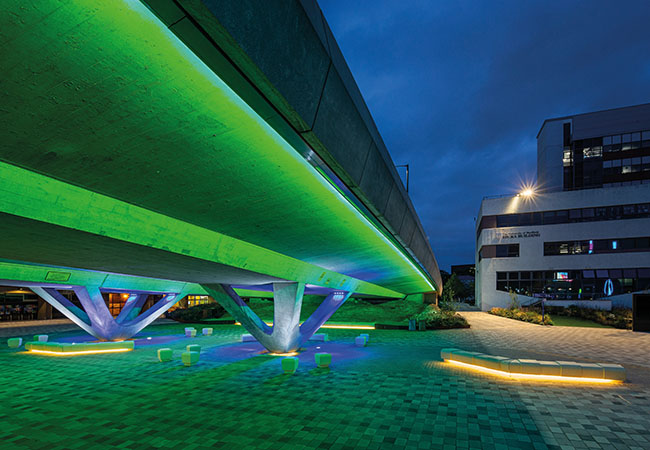
Two floors of CIBSE’s Saffron Hill head office have been refurbished to provide modern, functional spaces
The relocation of CIBSE’s head office to Saffron Hill, Farringdon, was successfully completed in December, with the transfer of 77 staff from Balham.
The move was celebrated in style with the office’s inaugural Christmas party, although with new carpets and upholstery recently fitted, red wine was left off the drinks menu.
Staff have moved into the top two floors of the building, which has five storeys plus mezzanine on the lower-ground floor. Staff areas have been refurbished to provide agile, functional spaces that reflect the outward-facing, collaborative values that CIBSE is keen to embrace.
Unlike Balham, where teams were siloed in their own rooms, Saffron Hill’s staff floors are open plan, with an internal balcony and exposed staircase providing a sense of light and space.
Staff work at traditional desks, railway carriage-style meeting pods, or individual workstations. Common areas, including two kitchens, encourage collaboration and creativity.
The response to the new 17,000ft2 office among employees is positive, with one new employee admitting he probably would not have taken the job if CIBSE had still been in Balham.
The arrival of staff at Saffron Hill completes the first part of the relocation project. The next phase is to open up the ground and lower-ground floors to members and stakeholders by building a vibrant skills hub to foster lifelong learning. This will comprise a training suite, versatile auditorium, and welcoming members’ lounge.
After completion later this year, CIBSE will monitor the building for a year before deciding on the decarbonisation strategy. Decisions made will be shared beyond CIBSE and will form the basis of an ongoing demonstration project.
Following an extensive tendering process, CIBSE appointed multidisciplinary consultant Inhabit to lead the project at the start of the process so the firm’s MEP expertise could be used to perform due diligence on the buildings being considered by CIBSE.

The new fit-out includes a variety of vibrant, flexible space
Colin Stuart, founding director at workplace consultant Baker Stuart, helped CIBSE write a brief for the appointment and worked with the CIBSE Premises Advisory Committee (PAC) through workshops to establish the Institution’s vision and values for its new home.
It became apparent to Stuart that the relocation was a chance for CIBSE to demonstrate best practice. ‘The idea is not to be the best of the best, but to show how a typical company can decarbonise its building on a reasonable budget, and create an office that makes staff feel valued,’ he says.
Saffron Hill was chosen because it most closely aligned with CIBSE’s vision. It met the original brief’s cost and functional needs, but also took account of secondary needs around membership and commercial growth.
‘Although the cost of fit-out and purchase is higher, the value delivered per square foot was the best of the lot. None of the other buildings we saw could provide the training and conference facilities, and members’ area, and the first floor allows for growth of CIBSE Services,’ says Stuart.
CIBSE was keen to appoint an MEP specialist to lead the project, in part because the services constitute the biggest part of the project and because the first phase of the project had to work with the future decarbonisation strategy.
‘We wanted it to be led by a CIBSE Member, which would bring MEP engineering front and centre,’ says Stuart. ‘Functionality and environmental performance were key for us. Inhibit had to design for day one and for five years’ time. It’s a delicate balancing act between making sure it’s a good, serviceable building now, while being mindful of the journey we’re going on.’
The appointment of Inhabit started with a call for expressions of interest in CIBSE Journal. The 36 respondents were sent a prequalification questionnaire and their answers were scored by PAC, with five being selected for tender. The tender document asked participants to devise a decarbonisation strategy for a sample office.
On this basis, the shortlist was whittled down to three and they were invited to interview with PAC. Based on the strategy and interview, Inhabit was selected unanimously.
‘Inhabit really impressed us in identifying what we wanted to achieve. It wasn’t about using the latest technology, but about doing good, robust engineering,’ says Stuart.
The building dates back to the 1950s and an extension was added in 2008. However, the HVAC condition was poor, says Stuart. ‘We had a robust risk process and we had a contingency for issues such as asbestos and reinforced autoclaved aerated concrete (RAAC) removal. We haven’t had to use the contingency for RAAC, but we’ve had to use some of it for rewiring,’ he says.
Many systems are coming to the end of their lives, including the boilers. There is no BMS and individual fan coil units are working against each other. Fire doors also need repair or replacement.
Stuart says there were no substantial issues with the structure or façade, but some of the windows weren’t opening properly. The façade will be included in Inhabit’s review of the decarbonisation strategy.
Inhabit is currently working with CIBSE on a monitoring regime. Areas being tracked include air quality, energy use and lighting.
‘We will look at the metrics and then decide what represents value for money for CIBSE as a landlord. What we don’t want to do is gild the lily and do something a typical landlord couldn’t afford to do,’ says Stuart. The process will also consider using accreditation schemes and standards such as NabersUK and the UK Net Zero Carbon Buildings Standard.
Stuart says: ‘The building needs to support CIBSE and its people. It needs to be extrovert – it’s not just about having 100 desks, it’s about what the building does for stakeholders.
Premises funding project
CIBSE’s move to its Saffron Hill premises marks a huge step for its ambition to provide first-class facilities that inspire, train and support tomorrow’s engineers.
CIBSE is seeking £2.5m funding to help support the second phase of development, which will include a training and events area, auditorium, meeting rooms, and designated areas for members, guests and staff. The new spaces will also allow CIBSE to host large-scale events and lectures.
The training and conference centre will provide an opportunity for companies to have a visible profile in the new facilities and align themselves with CIBSE’s commitment to supporting engineers.
If you are interested in funding opportunities, please contact Robert Astick at rastick@cibse.org.



